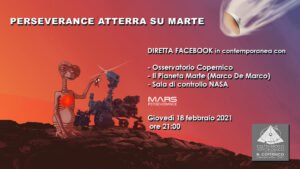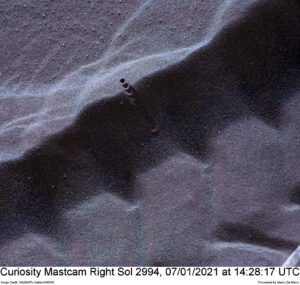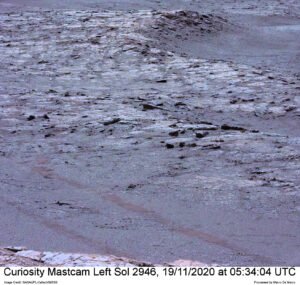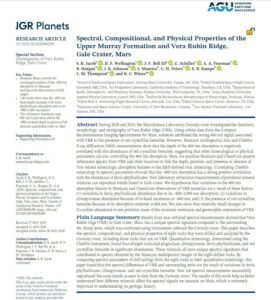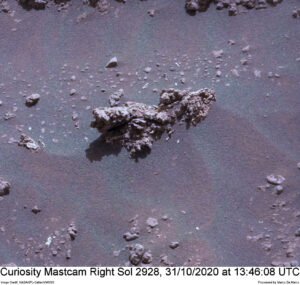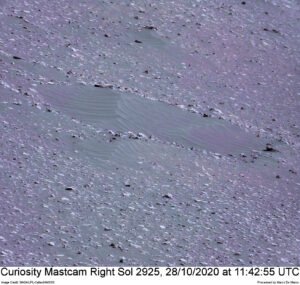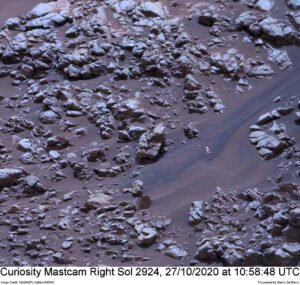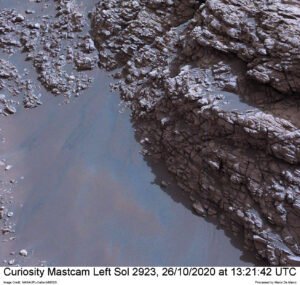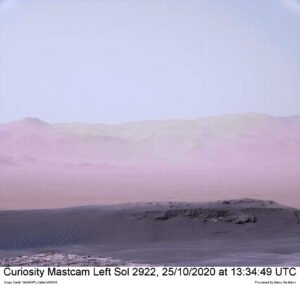Latest Posts
Perseverance lands on Mars
Tomorrow, February 18, 2021 from about 9 p.m., in conjunction with the Astronomical Observatory N. Copernicus (see https://www.facebook.com/groups/infocopernico), we will broadcast live images from the NASA operations center, to follow the landing of the probe Perseverance.Obviously, during the waiting moments, I and several members of the Observatory of Saludecio (RN) will speak about the landing site and the purpose of the mission in the Jezero crater.Fingers crossed… This post has been automatically translated. See the original post here.
Curiosity Sol 2994, January 7, 2021
At 14:28:17 UTC the Mastcam Right has taken in detail the trace impressed on the sand by one of the wheels of Curiosity.The contours are poorly defined, unlike other cases where instead they were extremely clear, probably because here the sand is extremely dry, at least on the surface.You can clearly see how just below the first surface layer the sand appears darker and bluish.In this case, the technicians of Curiosity have decided to deepen the chemical analysis using the laser spectrometer of ChemCam, producing that row of holes that start from the inside of the track and arrive until beyond the outer edge of the same.The original image is a black and white encoding of the Bayer mask that has been converted to color through a process called “debayering” or “demosaicing”. In addition, the photo has undergone a reduction in noise due to Jpeg compression, white balance and a slight increase in microcontrast and color saturation in order to make the colors more similar to what the human eye would see. Original image: https://mars.nasa.gov/msl-raw-images/msss/02994/mcam/2994MR0156160001303324C00_DXXX.jpg This post has been automatically translated. See the original post here.
Curiosity Sol 2993, January 6, 2021
At 09:17:36 UTC the Mars Hand Lens Imager (MAHLI) captured this very close detail of the Martian sand.The photo was taken from a distance of only 2.64 cm with a definition of 0.017 mm/pixel, thus covering an area of 2.64 cm X 1.96 cm.The largest grains measure about 0.7 mm, while averaging between 0.2 mm and 0.3 mm.Most of them, especially the smaller ones, show a smooth and distinctly spheroidal appearance, while the larger ones have more irregular shapes.The original image has undergone noise reduction due to Jpeg compression, white balance and a slight increase in microcontrast and color saturation in order to make the colors more similar to what the human eye would see. Original image: https://mars.nasa.gov/msl-raw-images/msss/02993/mhli/2993MH0007940010504840C00_DXXX.jpg This post has been automatically translated. See the original post here.
Curiosity Sol 2946, November 19, 2020
At 05:34:04 UTC the Mastcam Left has taken the traces left on the Martian soil by its own wheels.While in this shot the soil shows a prevalent turquoise coloration, the tracks left by Curiosity appear of the classic “Mars red” color.Moreover, the tracks themselves do not appear deep at all, thus revealing that the turquoise coloration is produced only in a thin surface layer.Since on Mars reddish dust is inexorably deposited everywhere, this thin turquoise layer must obviously be relatively “young”!What is it formed from and why does it form?The original image is a black and white encoding of the Bayer mask that has been converted to color through a process called “debayering” or “demosaicing”. In addition, the photo has undergone noise reduction due to Jpeg compression, white balance and a slight increase in microcontrast and color saturation in order to make the colors more similar to what the human eye would see. Original image: https://mars.nasa.gov/msl-raw-images/msss/02946/mcam/2946ML0153740461103397C00_DXXX.jpg This post has been automatically translated. See the original post here.
Physical, spectral, and compositional properties of “Murray” and “Vera Rubin Ridge” in the Martian crater Gale
Interesting results on the chemical analysis of Martian soil, not to be missed! Free downloadable full article:“Spectral, Compositional, and Physical Properties of the Upper Murray Formation and Vera Rubin Ridge, Gale Crater, Mars” https://agupubs.onlinelibrary.wiley.com/doi/epdf/10.1029/2019JE006290 https://agupubs.onlinelibrary.wiley.com/doi/10.1029/2019JE006290 This post has been automatically translated. See the original post here.
Curiosity Sol 2928, October 31, 2020
At 13:46:08 UTC the Mastcam Right captured a rock with a very singular appearance.Seen in small it looks a bit like a cornucopia shape, but of course when observed in detail is clearly a rock formed by small conglomerates.Always note the variety of colors present on the ground….The original image is a black and white encoding of the Bayer mask that has been converted to color through a process called “debayering” or “demosaicing”. In addition, the photo has undergone noise reduction due to Jpeg compression, white balance and a slight increase in microcontrast and color saturation in order to make the colors more similar to what the human eye would see. Original image: https://mars.nasa.gov/msl-raw-images/msss/02928/mcam/2928MR0152760001300806C00_DXXX.jpg This post has been automatically translated. See the original post here.
Curiosity Sol 2925, October 28, 2020
At 11:42:55 UTC the Mastcam Right imaged a small “crater” with peculiar characteristics.Given the perspective view, the shape appears elliptical but the true shape is most likely circular or nearly so. This feature leads to think that it is a small impact crater, but other details seem to contradict this hypothesis.Regarding the total lack of central depth it can be easily assumed that this has been filled by sand carried by the wind; in fact, the total lack of stones in the inner part seems to confirm this hypothesis.However, the peculiarity lies in the total absence of relief in the edge of this presumed impact crater, an edge that otherwise should be higher than both inside and outside.Moreover, since the edge is constituted mainly by rocks, it seems very improbable that these have been blunted by any form of erosion, considering that the rocks present on the edge show some shapes all but blunted if not even pointed!But if it had not been created by a meteorite, which other phenomenon would have generated a geometric form so regular?The original image is a black and white encoding of the Bayer mask that has been converted to color through a process called “debayering” or “demosaicing”. In addition, the photo has undergone noise reduction due to Jpeg compression, white balance and a slight increase in microcontrast and color saturation in order to make the colors more similar to what the human eye would see. Original image: https://mars.nasa.gov/msl-raw-images/msss/02925/mcam/2925MR0152640021300759C00_DXXX.jpg This post has been automatically translated. See the original post here.
Curiosity Sol 2924, October 27, 2020
At 10:58:48 UTC the Mastcam Right recorded a beautiful bluish “flow”.Note well how the flow has perfectly surrounded obstacles of significant size, which can only be produced by a liquid that spreads by capillary action and certainly not by a simple fall of sand!I also find interesting the greenish-turquoise coloring visible at the end of the casting…Definitely a nice set of interesting details!The original image is a black and white encoding of the Bayer mask that has been converted to color through a process called “debayering” or “demosaicing”. In addition, the photo has undergone noise reduction due to Jpeg compression, white balance and a slight increase in microcontrast and color saturation in order to make the colors more similar to what the human eye would see. Original image: https://mars.nasa.gov/msl-raw-images/msss/02924/mcam/2924MR0152570501300668C00_DXXX.jpg This post has been automatically translated. See the original post here.
Curiosity Sol 2923, October 26, 2020
At 13:21:42 UTC Mastcam Left captured outcrops of layered rocks from which conspicuous bluish flows depart.As in other similar cases, the surrounding rocks have an extremely complex surface, even though they are stratified rocks.It’s been a while since I’ve found such an interesting photo; who knows if it was due to the season or simply to the place examined…The original image has undergone noise reduction due to Jpeg compression, white balance and a slight increase in microcontrast and color saturation in order to make the colors more similar to what the human eye would see. Original image: https://mars.nasa.gov/msl-raw-images/msss/02923/mcam/2923ML0152530151101962E01_DXXX.jpg This post has been automatically translated. See the original post here.
Curiosity Sol 2922, October 25, 2020
At 13:34:49 UTC Mastcam Left has captured the inner rim of the Gale crater, discretely visible even with a partially hazy sky.The sky appears milky but the edge of the crater stands out and also shows areas of different color.As soon as I have a full Martian year at my disposal, I will show you how the color of the ground also varies with the season.To see what it would look like in good visibility conditions I recommend comparing it to the image taken on December 11, 2019 (see https://www.facebook.com/PianetaMarte.MdM/posts/2591188424297668). The original image is a black and white encoding of the Bayer mask that has been converted to color through a process called “debayering” or “demosaicing”. In addition, the photo has undergone noise reduction due to Jpeg compression, white balance and a slight increase in microcontrast and color saturation in order to make the colors more similar to what the human eye would see. Original image: https://mars.nasa.gov/msl-raw-images/msss/02922/mcam/2922ML0152490001101937C00_DXXX.jpg This post has been automatically translated. See the original post here.
